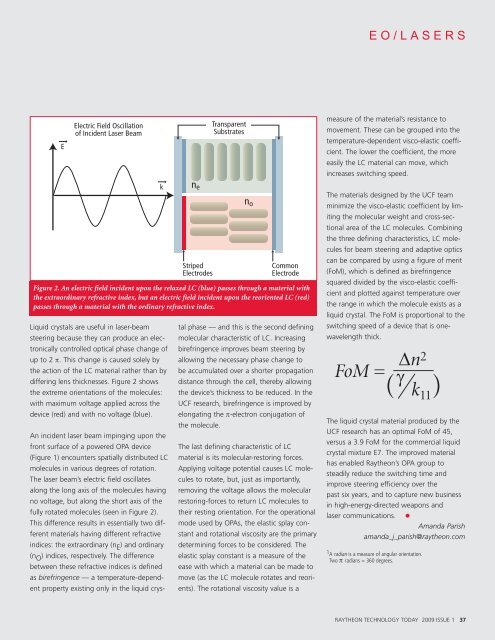2009 Issue 1 - Raytheon
2009 Issue 1 - Raytheon
2009 Issue 1 - Raytheon
You also want an ePaper? Increase the reach of your titles
YUMPU automatically turns print PDFs into web optimized ePapers that Google loves.
E<br />
Electric Field Oscillation<br />
of Incident Laser Beam<br />
Liquid crystals are useful in laser-beam<br />
steering because they can produce an electronically<br />
controlled optical phase change of<br />
up to 2 π. This change is caused solely by<br />
the action of the LC material rather than by<br />
differing lens thicknesses. Figure 2 shows<br />
the extreme orientations of the molecules:<br />
with maximum voltage applied across the<br />
device (red) and with no voltage (blue).<br />
An incident laser beam impinging upon the<br />
front surface of a powered OPA device<br />
(Figure 1) encounters spatially distributed LC<br />
molecules in various degrees of rotation.<br />
The laser beam’s electric field oscillates<br />
along the long axis of the molecules having<br />
no voltage, but along the short axis of the<br />
fully rotated molecules (seen in Figure 2).<br />
This difference results in essentially two different<br />
materials having different refractive<br />
indices: the extraordinary (nE ) and ordinary<br />
(nO ) indices, respectively. The difference<br />
between these refractive indices is defined<br />
as birefringence — a temperature-dependent<br />
property existing only in the liquid crys-<br />
k<br />
ne<br />
Striped<br />
Electrodes<br />
Transparent<br />
Substrates<br />
no<br />
Common<br />
Electrode<br />
Figure 2. An electric field incident upon the relaxed LC (blue) passes through a material with<br />
the extraordinary refractive index, but an electric field incident upon the reoriented LC (red)<br />
passes through a material with the ordinary refractive index.<br />
tal phase — and this is the second defining<br />
molecular characteristic of LC. Increasing<br />
birefringence improves beam steering by<br />
allowing the necessary phase change to<br />
be accumulated over a shorter propagation<br />
distance through the cell, thereby allowing<br />
the device’s thickness to be reduced. In the<br />
UCF research, birefringence is improved by<br />
elongating the π-electron conjugation of<br />
the molecule.<br />
The last defining characteristic of LC<br />
material is its molecular-restoring forces.<br />
Applying voltage potential causes LC molecules<br />
to rotate, but, just as importantly,<br />
removing the voltage allows the molecular<br />
restoring-forces to return LC molecules to<br />
their resting orientation. For the operational<br />
mode used by OPAs, the elastic splay constant<br />
and rotational viscosity are the primary<br />
determining forces to be considered. The<br />
elastic splay constant is a measure of the<br />
ease with which a material can be made to<br />
move (as the LC molecule rotates and reorients).<br />
The rotational viscosity value is a<br />
EO/LASERS<br />
measure of the material’s resistance to<br />
movement. These can be grouped into the<br />
temperature-dependent visco-elastic coefficient.<br />
The lower the coefficient, the more<br />
easily the LC material can move, which<br />
increases switching speed.<br />
The materials designed by the UCF team<br />
minimize the visco-elastic coefficient by limiting<br />
the molecular weight and cross-sectional<br />
area of the LC molecules. Combining<br />
the three defining characteristics, LC molecules<br />
for beam steering and adaptive optics<br />
can be compared by using a figure of merit<br />
(FoM), which is defined as birefringence<br />
squared divided by the visco-elastic coefficient<br />
and plotted against temperature over<br />
the range in which the molecule exists as a<br />
liquid crystal. The FoM is proportional to the<br />
switching speed of a device that is onewavelength<br />
thick.<br />
The liquid crystal material produced by the<br />
UCF research has an optimal FoM of 45,<br />
versus a 3.9 FoM for the commercial liquid<br />
crystal mixture E7. The improved material<br />
has enabled <strong>Raytheon</strong>’s OPA group to<br />
steadily reduce the switching time and<br />
improve steering efficiency over the<br />
past six years, and to capture new business<br />
in high-energy-directed weapons and<br />
laser communications.<br />
Amanda Parish<br />
amanda_j_parish@raytheon.com<br />
1 A radian is a measure of angular orientation.<br />
Two π radians = 360 degrees.<br />
RAYTHEON TECHNOLOGY TODAY <strong>2009</strong> ISSUE 1 37

















